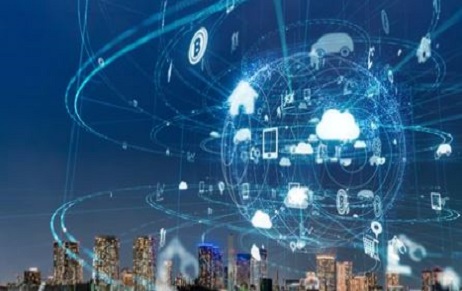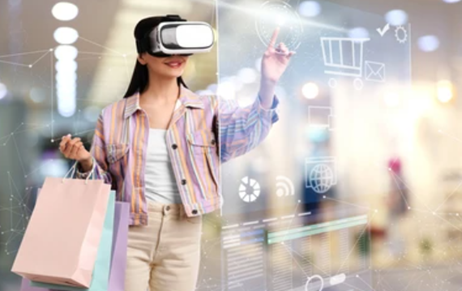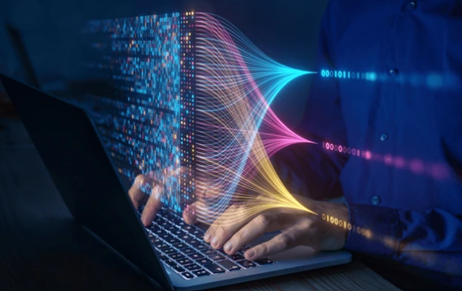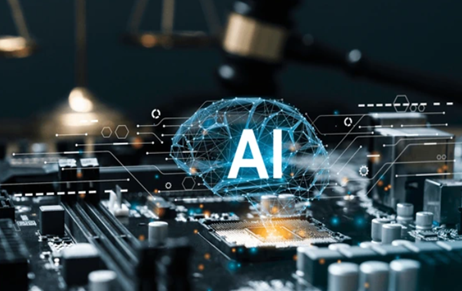In recent years, the world witnessed an exponential surge in the use of Artificial Intelligence…
The Tangled Web of Artificial Intelligence and Intellectual Property Rights
A new era started with the innovation of Artificial Intelligence (AI). AI systems can produce creative and novel outputs, such as computer programs, innovative ideas and artistic work, music, and other outputs. This digital advancement, raises a difficult legal question: Who is to be deemed as the rightful owner and credit bearer of output produced by AI? Is it the Artist/s from whom the work has been “inspired” from? or is it the final ‘by-product” of the AI search result?
Artificial intelligence (AI) is an efficient power of a computer or robot under computer control with bombardments of coding, to conduct operations typically performed by intelligent beings. The phrase is commonly used to describe the endeavour of creating artificial intelligence systems that include human-like cognitive functions, like reasoning, meaning-finding, generalization, and experience-based learning. In lay man’s aptitude, AI is a machine learning code that has been programmed to self-learn, adapt, and ultimately help the humans.
The subject of “authorship” and “ownership” in the dynamic field of intellectual property has always been a tricky issue. It is now possible to create creative and even artistic outputs with Artificial Intelligence (AI), like turning a proper in-detail prompt about a dance into a full-fledged choreography, creating a painting, providing with the song and many more. This time, the focus is not just on the original creator but additionally on the meaning of “author” also. It becomes essential to evaluate the definition of “authorship” and who qualifies as an author to decide if AI-generated works should be protected by copyright and, if so, who should be given credit for their creation.
Consider giving an Artificial Intelligence (AI) system command-prompt from a user to write a song in a particular artist’s style. The finished musical composition poses a complex authorship difficulty even though it is unquestionably original. Similar issues may come up in other creative domains, such as writing’s where Artificial Intelligence (AI) are able to produce poems or scripts in response to given commands. Determining the owner and author of these outputs becomes essential for ethical reasons such as acknowledgment and attribution, as well as for legal concerns such as copyright protection.
To understand the question raised above, it is necessary to understand the concept of “Author.” The Berne Convention nowhere defined the term “Author” and therefore it was the duty of the contracting states to define the term “Author.”
As per the Indian Copyright Act of 1957 Section 2(d) state the definition of Copyright.
An “author” means, —
(i) in relation to a literary or dramatic work, the author of the work;
(ii) in relation to a musical work, the composer;
(iii) in relation to an artistic work other than a photograph, the artist;
(iv) in relation to a photograph, the person taking the photograph;
[(v) in relation to a cinematograph film or sound recording, the producer; and
(vi) in relation to any literary, dramatic, musical or artistic work which is computer-generated, the person who causes the work to be created;]
In simple words, an author is a person who composes or writes the work either all by himself or with any other person or a direction given by any other person.
However, the InfoSoc Directive[1] is usually silent on requirements for a person to be an author. There are various other provisions under the InfoSoc Directive which gives some hints on who can be regarded as an author- human being. Article 2a, Article 3(1) and Article 4(1) states some of the rights that can be exercised by an author. The court of Justice of the European Union (CJEU) states that the Directive provides author with the exclusive right to economic rights[2] however, it is not possible for a non-human to be an author. Similarly, in the Software Directive[3], it does not define Software, but it does contain provisions that talks about authorship. This shows that the idea of an “author” is often understood to be a human being. This concept can very occasionally be waived, and those instances must be made clear in the legislation. After going through all the things, it can be said that the EU laws are human centred[4] which is why it suggests that the author of a work must be a human individual.

Section 17[5] of the act, states that an author is the first owner of a particular work. Whereas article 4(2) of the Directive[6], states the right of an author of a work to transfer the ownership by an author.
The concept of authorship and ownership has played a crucial role in determining who has right over a property but is the not this simple when it comes to determining the rights and liabilities over the content generated by AI. This problem becomes more tangled when it is between the three that is the coder (the person who wrote the code for the Artificial Intelligence), the AI System (the AI system that generated the work) and the user (the person who gave the command or input).
The Naruto v. David Slater[7] case, which is popularly referred to as “The Monkey Selfie Case” has been one of the most well know case that talked about the concept of authorship and ownership. In this case a group of wild macaques snapped several pictures, including selfies, when a professional photographer left his camera equipment out for them to examine. Naruto, one of them, snapped several pictures, including the infamous “monkey selfies.” Following the public release of these images, a legal dispute arose on who should have the ownership rights to them—the macaques who clicked the camera or the human photographer? As a result, it raised an important concern regarding the validity of copyright claims made by non-human entities, such as artificial intelligence computers or monkeys.
The US Copyright Office has consistently maintained that works produced by computers or other non-human entities are not protected by copyright. As a result, generative AI model output is not protected by copyright.
The “computer-generated” work which includes works produced automatically by an algorithm without a human author is guaranteed protection under copyright for fifty years after it is created under UK law[8].
However, there are still various states who have not protected the work that is generated. Where there are countries like UK who have established a law to protect the work, there still are countries like USA who have not established any law to protect it. It takes time for a state to look through the situation and created a legislation that will protect the work generated by AI or any other algorithm.
The EU AI Act
The European Union AI Act, which was enacted in 2024, governs the moral advancement and application of AI throughout the European Union. It assigns a risk-based classification to AI systems, with more severe requirements for high-risk domains. The statute places a strong emphasis on protecting fundamental rights across all stages of AI and prevents causing damage. The objective of this law is to safeguard the European Union people, encourage ethical innovation, and increase public confidence in AI.
The Act establishes that the AI system shall be transparent, so that it would be easy to address the concerns related to the infringement of copyrighted work. Additionally, the Act places more stringent limitations on the creation, application, and use of some of the AI systems by categorising them as “high-risk” systems. This could mean establishing precise guidelines for how these technologies can be protected.
The Act places legal duty on the developers, deployers, users, and other stakeholders involved in use of Artificial Intelligence. The Act’s main focus is in making sure that the AI operates in a morally and safely manner. It is difficult to define who owns AI legally and philosophically. The legal systems in place are built for human ownership, hence there are several difficulties when using them with artificial intelligence. The Act stays out of this tangled discussion and concentrates on the beneficial aspects of controlling AI. Since AI technology is developing quickly, it may be necessary to define and further explore the concept of “authorship” and “ownership” in this context in the future. The Act allows for future debates and possible revisions as the legal system and technology advance.
It is crucial to keep in mind that the AI Act is still being implemented and that its complete effects on intellectual property rights are still unknown. It does, however, draw attention to the expanding understanding of the complex link between AI and intellectual property in EU law.
Suggestion and Conclusion
Since the time, the rights were given, and the works were recognised and protected, the concept of authorship and ownership has played a vital role in determining the rights and liabilities of the owner with respect to the protected work.
But when it comes to the work created by an Artificial Intelligence is not that simple to determine who will be the rightful owner of the work and would be able to exercise the rights.
However, there is a gap between the concept of the “authorship” and “ownership” although it is difficult to resolve but is possible to solve. As per the Copyright Act of 1957, there is a concept of “joint authorship”. Section 2(z) of the act defines work of “joint authorship” as “produced by the collaboration of two or more authors in which the contribution of one author is not distinct from the contribution of the other author or authors.”
The Delhi High Court[9], in this case while explaining the concept of “joint authorship” held that when there is a dispute regarding the ownership, both the parties can have equal rights and liabilities. Referring to this judgement we can apply the same concept while determining the ownership of AI generated work. We could provide equal rights and liabilities to both the AI system generating the work and the person giving the command as we cannot solely blame the AI system as without the prompt command the system would not have generated the content since, the right is being shared then the liability should also be shared.
Author: Mahek Panjwani, in case of any queries please contact/write back to us via email to chhavi@khuranaandkhurana.com or at IIPRD.
[1] Directive 2001/29/EC of the European Parliament and Council on harmonization of certain aspects of copyright and related rights in the information society [2001] OJ L167/10
[2] Hewlett-Packard Belgium SPRL V Reprobel SCRL, C-572/13. EU:C: 2015:750
[3] Directive 2009/24/EC of the European Parliament and the council on the legal protection of computer programs [2009] OJ L111/16
[4] Maria Iglesias, Sheron Shamuilia and Amanda Anderberg, “Intellectual Property and Artificial Intelligence- A Literature Review,” Joint Research Centre (JRC), European Union, EUR 30017 EN
[5] The Copyright Act, 1957
[6] Directive 2001/29/EC of the European Parliament and Council on harmonization of certain aspects of copyright and related rights in the information society [2001] OJ L167/10
[7] 888 F.3d 418 (9th Cir. 2018).
[8] Section 178, Copyright, Designs and Patents Act 1988 (CDPA) (UK)
[9] Najma Heptulla vs Orient Longman Ltd. And Ors. AIR 1989 Delhi 63.



